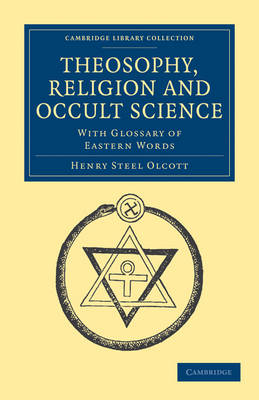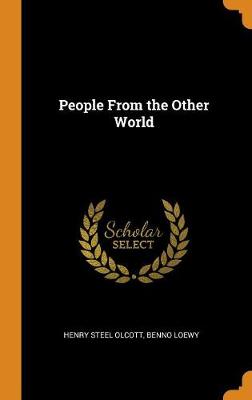Cambridge Library Collection - Spiritualism and Esoteric Knowledge
6 total works
The renowned lawyer and journalist Henry Steel Olcott (1832-1907) published this work in 1885. In this work Olcott carefully lays out his arguments for the basis of theosophy, arguing for the truth of all religions because they share the same ancient roots or 'ur-religion'. As a founding member and the first president of the Theosophical Society, Olcott uses the work to set out the aims and objectives of the Society and attempts to reconcile his spiritual beliefs with science, reason and modernity. The work also includes accounts of his attempted empirical investigations into hypnotism, mesmerism and other spiritualist activities. The final chapters include discussions of India, Buddhism and Zoroastrian religion. The work was deeply influenced by Helena Blavatsky (1831-1891), then Olcott's close friend but later his opponent. It is a key text of the nineteenth-century theosophical movement and is an indispensable source for research into Victorian occult philosophy.
The lawyer and journalist Henry Steel Olcott (1832-1907) published People from the Other World in 1875. Part 1 of the work is a careful account of Olcott's 1874 investigations into the famous Eddy brothers of Chittenden, Vermont, and their claimed psychic powers. Part 2 is a report into two Philadelphia mediums who claimed to be able to call up two spirits called John and Katie King. The account includes descriptions of seances, healings, levitation, teleportation and the famous Compton transfiguration. Olcott, a founding member of the Theosophical Society and its first president, was a pioneer of psychical research. This work, deeply influenced by Helena Blavatsky (1831-1891), who he met at Chittenden, is one of his most popular. It offers an important insight into the nineteenth-century fascination with the occult and is a classic example of a Victorian attempt to approach the supernatural with the rigours of scientific investigation.
Henry Steel Olcott (1832-1907), co-founder of the Theosophical Society, was a versatile man. He is regarded as one of the pioneers of American agricultural education and also served in the U.S. War Department. Later Olcott was admitted to the New York Bar and became interested in psychology and spiritualism, travelling to India and Sri Lanka with Madame Blavatsky to explore eastern spiritual traditions, especially Buddhism. In this polemical volume (first published in 1932), Olcott describes his view of the history of the Society between 1893 and 1896: conflicts and long-standing tensions had led to a split in 1895, precipitated by a clash between Olcott and William Judge, Vice-President of the Society in America. After the split Olcott carried on travelling widely and lecturing, having established a study centre in Chennai, India, for the movement now known as the Theosophical Society - Adyar.
Henry Steel Olcott (1832-1907), co-founder of the Theosophical Society, was a versatile man. He is regarded as one of the pioneers of American agricultural education and also served in the U.S. War Department. Later Olcott was admitted to the New York Bar and became interested in psychology and spiritualism, travelling to India and Sri Lanka with Madame Blavatsky to explore eastern spiritual traditions, especially Buddhism. This volume (1895) describes the first meeting between Olcott and Madame Blavatsky and the founding of the Theosophical Society in 1875. Olcott continued to practise as a lawyer (and supported the Society financially) while in the evenings he and Madame Blavatsky would entertain visitors or collaborate on the book Isis Unveiled. The author portrays his friend as a spiritual medium and describes how Madame Blavatsky's body was from time to time possessed by other 'entities'.
Henry Steel Olcott (1832-1907), co-founder of the Theosophical Society, was a versatile man. He is regarded as one of the pioneers of American agricultural education and also served in the U.S. War Department. Later Olcott was admitted to the New York Bar and became interested in psychology and spiritualism, travelling to India and Sri Lanka with Madame Blavatsky to explore eastern spiritual traditions, especially Buddhism. This volume covers the period 1883-1887: Olcott tells of his meetings with many of the 'Masters' of the Society and considers what has been achieved since he and Madame Blavatsky met in Vermont in 1874. He is invited to Burma by its king, who is interested in hearing about Olcott's work; Madame Blavatsky resigns as Corresponding Secretary of the Society and goes into exile in Europe. The author, however, is determined to give a fair assessment of her invaluable contribution to the Society.
Henry Steel Olcott (1832-1907), co-founder of the Theosophical Society, was a versatile man. He is regarded as one of the pioneers of American agricultural education and also served in the U.S. War Department. Later Olcott was admitted to the New York Bar and became interested in psychology and spiritualism, travelling to India and Sri Lanka with Madame Blavatsky to explore eastern spiritual traditions, especially Buddhism. In this volume (published in 1900) Olcott chronicles how he and Madame Blavatsky journeyed to India and Sri Lanka (then Ceylon) in the years 1878 to 1883 to oversee the foundation of new branches of their Society. This is part classic travel writing in which the author gives breathless descriptions of the beauty of Indian nature, culture and philosophy and part characterisation of Madame Blavatsky's 'psychological eccentricities' as Olcott experiences them. To him she was and remained 'an insoluble riddle'.


